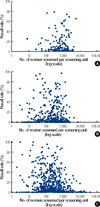Abstract
Purpose
The Korean National Cancer Screening Program began in 1999. To provide essential evidence related to breast cancer screening in Korean women, we analyzed data from the KNCSP in 2008.
Methods
Using data obtained from the National Cancer Screening Information System, breast cancer screening participation rates were calculated. Recall rates were estimated with 95% confidence intervals (CI).
Results
The target population of breast cancer screening in 2008 included 3,706,062 women, 1,294,060 of whom utilized mammography as a screening tool (participation rate, 34.9%). Compared to the participation rate of women covered by the National Health Insurance Program (37.3%), women covered by the Medical Aid Program was lower (21.3%). The overall recall rate of breast cancer screening was 6.4% (95% CI, 6.39-6.47).
Figures and Tables
Figure 1
Number of women screened by health insurance type and age from the Korean National Cancer Screening Program, 2008.

Figure 2
Participation rates by health insurance type and age from the Korean National Cancer Screening Program, 2008.

Figure 4
Recall rates by number of women screened per screening unit from the Korean National Cancer Screening Program, 2008. Blue dots mean screening units. (A) General hospital (n=300). (B) Hospital (n=557). (C) Clinic (n=1,001). The horizontal axis represents number of women (range, 1-31,813) screened with mammography according to screening units. Because recall rates by screening units follow a Poisson distribution, the horizontal line's scale is a logarithmic scale.

References
1. Jung KW, Won YJ, Park S, Kong HJ, Sung J, Shin HR, et al. Cancer statistics in Korea: incidence, mortality and survival in 2005. J Korean Med Sci. 2009. 24:995–1003.

2. Jun JK, Kim YJ, Gwack J, Choi Y, Hong YC, Yoo KY. Mortality trends in colorectal cancer and breast cancer in Korea: birth cohort effects? Korean J Epidemiol. 2005. 27:154–162.
3. Yoo KY, Noh DY, Lee ES. National guidelines for breast cancer screening. J Korean Med Assoc. 2002. 45:992–1004.

4. Perry N, Broeders M, de Wolf C, Tornberg S, Hölland R, von Karsa L. European Guidelines for Quality Assurance in Breast Cancer Screening and Diagnosis. 2006. 4th ed. Brussels: European Communities;53–54.
5. Bastos J, Peleteiro B, Gouveia J, Coleman MP, Lunet N. The state of the art of cancer control in 30 European countries in 2008. Int J Cancer. 2010. 126:2700–2715.

6. U.S. Department of Health and Human Services. The National Breast and Cervical Cancer Early Detection Program 1991-2002 National Report. 2005. Atlanta: Centers for Disease Control and Prevention.
7. Smith RA, Cokkinides V, Brawley OW. Cancer screening in the United States, 2009: a review of current American Cancer Society guidelines and issues in cancer screening. CA Cancer J Clin. 2009. 59:27–41.

8. Cancer Trends Progress Report. National Cancer Institute. May 28th, 2010. http://progressreport.cancer.gov/doc_detail.asp?pid=1&did=2007&chid=72&coid=716&mid=#trends.
9. Ministry of Health, Labour and Welfare, Japan. May 28th, 2010. http://www.mhlw.go.jp/shingi/2004/04/s0427-2.html.
10. Health Statistics in Japan, 2007. Ministry of Health, Labour and Welfare, Japan. May 28th, 2010. http://www.mhlw.go.jp/english/database/db-hss/dl/hs2007a.pdf.
11. Ministry of Health, Labour and Welfare, Japan. May 28th, 2010. http://www.mhlw.go.jp/toukei/saikin/hw/c-hoken/06/r8.html.
12. Day NE, Williams DR, Khaw KT. Breast cancer screening programmes: the development of a monitoring and evaluation system. Br J Cancer. 1989. 59:954–958.

13. Tabar L, Fagerberg G, Chen HH, Duffy SW, Smart CR, Gad A, et al. Efficacy of breast cancer screening by age: new results from the Swedish Two-County Trial. Cancer. 1995. 75:2507–2517.

14. Kim SW, Han W, Jeong J, Park HK, Noh WC, Lee ES, et al. The policy proposal for effective prevention and management of breast cancer. J Breast Cancer. 2006. 9:270–292.

15. Hur MH, Lee HK, Kang WN, Yoon CS, Ko SS, Lee YJ, et al. Breast cancer screening: a medical audit of the screening mammography performed at one institution for 10 years. J Breast Cancer. 2008. 11:180–186.

16. Choi N, Lee A, Lee HK, Yi BH, Cha JG. Mammogrphic screening provided by the National Health Insurance Corporation: a 1 year audit in a secondary medical institution. J Korean Radiol Soc. 2009. 60:51–55.

17. Kim JY, Han BK, Choe YH, Kim JH. Screening mammogram in health center: medical audit for six years. J Korean Radiol Soc. 2003. 49:137–142.

18. National Cancer Center, Ministry for Health Welfare and Family Affairs. Cancer Facts and Figures 2009. 2009. Goyang: National Cancer Center;47–56.
19. Kim SH, Kim MH, Oh KK. Analysis and comparison of breast density according to age on mammogram between Korean and Western women. J Korean Radiol Soc. 2000. 42:1009–1014.

20. National Cancer Center. Development on evaluation of a comprehensive regional cancer center and operational framework for the specified regional cancer center. 2008. Goyang: National Cancer Center;160–163.




 PDF
PDF ePub
ePub Citation
Citation Print
Print




 XML Download
XML Download